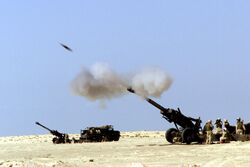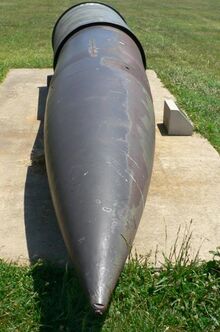Projectile
Topic: Physics
 From HandWiki - Reading time: 5 min
From HandWiki - Reading time: 5 min

A projectile is an object that is propelled by the application of an external force and then moves freely under the influence of gravity and air resistance.[1][2] Although any objects in motion through space are projectiles, they are commonly found in warfare and sports (for example, a thrown baseball, kicked football, fired bullet, shot arrow, stone released from catapult).[3][4]
In ballistics mathematical equations of motion are used to analyze projectile trajectories through launch, flight, and impact.
Motive force

Blowguns and pneumatic rifles use compressed gases, while most other guns and cannons utilize expanding gases liberated by sudden chemical reactions by propellants like smokeless powder. Light-gas guns use a combination of these mechanisms.
Railguns utilize electromagnetic fields to provide a constant acceleration along the entire length of the device, greatly increasing the muzzle velocity.
Some projectiles provide propulsion during flight by means of a rocket engine or jet engine. In military terminology, a rocket is unguided, while a missile is guided. Note the two meanings of "rocket" (weapon and engine): an ICBM is a guided missile with a rocket engine.
An explosion, whether or not by a weapon, causes the debris to act as multiple high velocity projectiles. An explosive weapon or device may also be designed to produce many high velocity projectiles by the break-up of its casing; these are correctly termed fragments.
In sports
In projectile motion the most important force applied to the ‘projectile’ is the propelling force, in this case the propelling forces are the muscles that act upon the ball to make it move, and the stronger the force applied, the more propelling force, which means the projectile (the ball) will travel farther. See pitching, bowling.
As a weapon
Delivery projectiles
Many projectiles, e.g. shells, may carry an explosive charge or another chemical or biological substance. Aside from explosive payload, a projectile can be designed to cause special damage, e.g. fire (see also early thermal weapons), or poisoning (see also arrow poison).
Kinetic projectiles
Wired projectiles
Some projectiles stay connected by a cable to the launch equipment after launching it:
- for guidance: wire-guided missile (range up to 4,000 metres or 13,000 feet)
- to administer an electric shock, as in the case of a Taser (range up to 10.6 metres or 35 feet); two projectiles are shot simultaneously, each with a cable.
- to make a connection with the target, either to tow it towards the launcher, as with a whaling harpoon, or to draw the launcher to the target, as a grappling hook does.
Typical projectile speeds
This section's factual accuracy is disputed. (December 2018) (Learn how and when to remove this template message) |
| Projectile | Speed | Specific kinetic energy (J/kg) | |||
|---|---|---|---|---|---|
| (m/s) | (km/h) | (ft/s) | (mph) | ||
| Object falling 1 m (in vacuum, at Earth's surface) | 4.43 | 15.948 | 14.5 | 9.9 | 9.8 |
| Object falling 10 m (in vacuum, at Earth's surface) | 14 | 50.4 | 46 | 31 | 98 |
| Thrown club (expert thrower) | 40 | 144 | 130 | 90 | 800 |
| Object falling 100 m (in vacuum, at Earth's surface) | 45 | 162 | 150 | 100 | 980 |
| Refined (flexible) atlatl dart (expert thrower) | 45 | 162 | 150 | 100 | 1,000 |
| Ice hockey puck (slapshot, professional player) | 50 | 180 | 165 | 110 | 1,300 |
| 80-lb-draw pistol crossbow bolt | 58 | 208.8 | 190 | 130 | 1,700 |
| War arrow shot from a 150 lbs medieval warbow | 63 | 228.2 | 208 | 141 | 2,000 |
| Blunt Impact Projectile shot from a 40mm grenade launcher | 87 | 313.2 | 285 | 194.6 | 3,785 |
| Paintball fired from marker | 91 | 327.6 | 300 | 204 | 4,100 |
| 175-lb-draw crossbow bolt | 97 | 349.2 | 320 | 217 | 4,700 |
| 6 mm Airsoft pellet | 100 | 360 | 328 | 224 | 5,000 |
| Air Rifle BB 4.5 mm | 150 | 540 | 492 | 336 | 11,000 |
| Air gun pellet .177" (magnum-power air rifle) | 305 | 878.4 | 1,000 | 545 | 29,800 |
| 9×19mm (bullet of a pistol) | 340 | 1224 | 1,116 | 761 | 58,000 |
| 12.7×99 mm (bullet of a heavy machine gun) | 800 | 2,880 | 2,625 | 1,790 | 320,000 |
| German Tiger I 88 mm (tank shell- Pzgr. 39 APCBCHE) | 810 | 2,899 | 2,657 | 1,812 | 328,050 |
| 5.56×45mm (standard round used in many modern rifles) | 920 | 3,312 | 3,018 | 2,058 | 470,000 |
| 20×102mm (standard US cannon round used in fighter cannons) | 1,039 | 3,741 | 3,410 | 2,325 | 540,000 |
| 25×140mm (APFSDS, tank penetrator) | 1,700 | 6,120 | 5,577 | 3,803 | 1,400,000 |
| 2 kg tungsten Slug (from Experimental Railgun) | 3,000 | 10,800 | 9,843 | 6,711 | 4,500,000 |
| MRBM reentry vehicle | Up to 4,000 | Up to 14,000 | Up to 13,000 | Up to 9,000 | Up to 8,000,000 |
| projectile of a light-gas gun | Up to 7,000 | Up to 25,000 | Up to 23,000 | Up to 16,000 | Up to 24,000,000 |
| Satellite in low Earth orbit | 8,000 | 29,000 | 26,000 | 19,000 | 32,000,000 |
| Exoatmospheric Kill Vehicle | ~10,000 | ~36,000 | ~33,000 | ~22,000 | ~50,000,000 |
| Projectile (e.g., space debris) and target both in low Earth orbit | 0–16,000 | ~58,000 | ~53,000 | ~36,000 | ~130,000,000 |
| 7 TeV particle in LHC[6] | 299,792,455 [note 1] | 1,079,252,839 | 983571079 | 670,616,536 | ~6.7 × 1020 [note 2] |
Equations of motion
An object projected at an angle to the horizontal has both the vertical and horizontal components of velocity. The vertical component of the velocity on the y-axis is given as
1. Time to reach maximum height. It is symbolized as (
2. Time of flight (
3. Maximum Height (
4. Range (
See also
- Atlatl
- Ballistics
- Gunpowder
- Bullet
- Impact depth
- Kinetic bombardment
- Shell (projectile)
- Projectile point
- Projectile use by animals
- Arrow
- Dart
- Missile
- Sling ammunition
- Spear
- Torpedo
- Range of a projectile
- Space debris
- Trajectory of a projectile
Notes
References
- ↑ Pius, Okeke; Maduka, Anyakoha (2001). Senior Secondary School Physics. Macmillan,Lagos, Nigeria.
- ↑ "projectile". http://www.merriam-webster.com/dictionary/projectile.
- ↑ "projectile". http://www.thefreedictionary.com/projectile.
- ↑ "projectile". http://dictionary.reference.com/browse/projectile.
- ↑ Pepin, Matt (2010-08-26). "Aroldis Chapman hits 105 mph". Boston.com. http://www.boston.com/sports/blogs/thebuzz/2010/08/aroldis_chapman.html.
- ↑ "Facts and figures". CERN. 2008. http://public-archive.web.cern.ch/public-archive/en/lhc/Facts-en.html.
- Heidi Knecht (29 June 2013). Projectile Technology. Springer Science & Business Media. ISBN 978-1-4899-1851-2. https://books.google.com/books?id=zS2SBgAAQBAJ&q=Semyonov+chahars.
External links
 |
35 views | Status: cached on July 13 2024 22:57:30
↧ Download this article as ZWI file
 KSF
KSF
